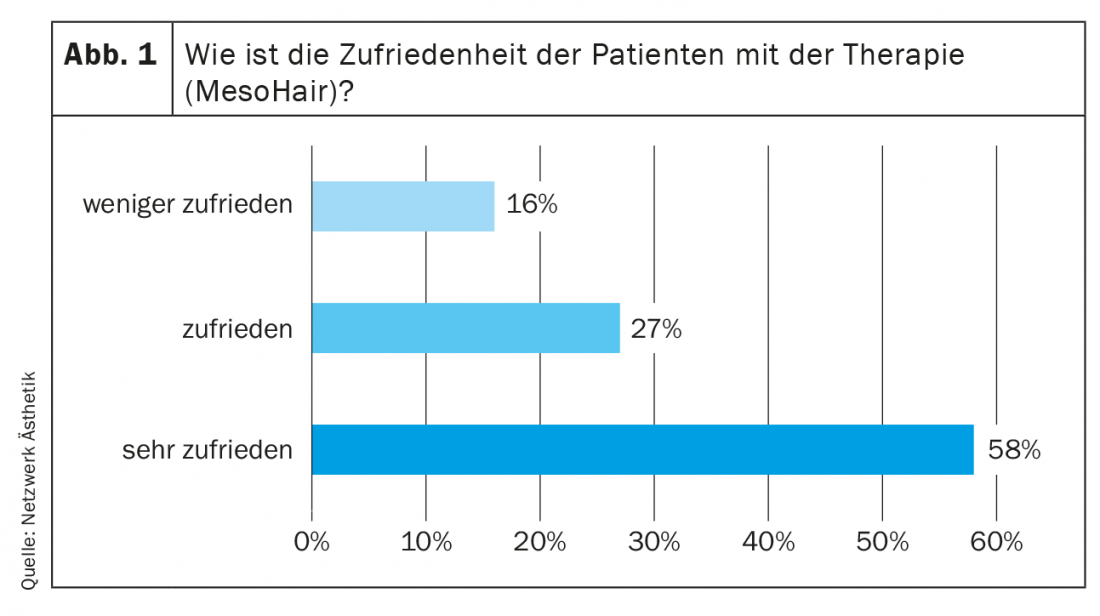The topic of hair loss is playing an increasingly important role in dermatology. More and more patients – especially females – do not want to accept the fact that their hair is falling out. While in the past patients with hair loss were not particularly welcome in practices due to a lack of treatment options, the situation has changed in recent years.
The topic of hair loss is playing an increasingly important role in dermatology. More and more patients – especially females – do not want to accept the fact that their hair is falling out. While in the past patients with hair loss were not particularly welcome in practices due to a lack of treatment options, the situation has changed in recent years. Thus, the colleague Schaart from Hamburg was the first to develop a consistent concept for a hair consultation, which should take into account the just mentioned needs for successful treatment.
The Aesthetics Network, of which I am the medical director, has also been working on this topic since 2007. As part of the development of a standardized treatment protocol for mesotherapy based purely on aesthetic indications, Ready Made mixtures were developed by our members for two indications, for the improvement of skin structure and the treatment of hair loss.
The network’s MesoLift and MesoHair cocktails have been in use since 2009 [1–9]. In addition, an advanced training course exclusively for physicians has been developed that provides a clear treatment protocol in hands-on training for this therapy.
Status quo 2020
By 2020, this training was expanded to include two additional therapies that fall under the rubric of “regenerative aesthetics” because sufficient studies were presented on them: PRP therapy and needling, which was scientifically investigated primarily by colleague Aust and thoroughly tested in practice by our member Kai Rezai [10–17]. PRP became a real boom. In the meantime, numerous studies have been conducted and published on this therapy, especially on the therapy of hair loss, so that it can be said that there is already relatively good evidence for its effectiveness here [18–65]. Regenerative – to be defined here again – means that only methods that do not require destruction of cells by heat or cold (e.g. laser, RF, cryo, …) are used for skin improvement.
The hair loss indications we have treated so far are Alopecia Areata and diffuse effluvium, both with good results.
The general conditions for a successful start of therapy
Especially in the case of therapies that are carried out on the basis of an individual healing attempt, it is necessary that the practitioners adhere to certain rules. Thus, we have decided in the network to concentrate on hair loss in female patients and to use alternative therapies only if we have not been able to achieve sufficient therapeutic success with the therapies included in the recommendations for dermatologists. Only then are the patients, who usually visit the practice in desperation, offered further therapy.
We can start from some conditions about which there should be clarity and agreement between the practitioner and the patient before the treatment: The first is that we must rightly assume that the hair follicles must not be dead yet, but only inactive, if there is to be a chance of success. In plain language, this means that the time interval between the beginning of hair loss and the beginning of therapy should be as short as possible, we recommend no longer than two years. In individual cases, we have also been able to achieve success when the hair loss has been present for a longer period of time, but the chances worsen the longer the condition has existed.
There should also be agreement on the minimum and maximum goals of a treatment. Here it is that we define three different goals:
Goal 1: Hair loss should be stopped. This is the minimum goal and the patient should accept that greater success may not be achieved with the help of mesotherapy and/or PRP.
Goal 2: The remaining hairs should be protected and stabilized. This objective defines that the long-term nature of the measures implemented remains guaranteed. Unfortunately, there is no simple and good diagnostics to objectively determine the condition of the hair. However, patients can usually tell exactly if their hair feels better, is thicker, less brittle, etc.
Goal 3: New hair growth in the affected areas. This is the goal that doctors and patients alike hope to achieve. If it does not occur, the therapy is less successful. Nevertheless, goals 1 and 2 should not be dismissed, and operating only and exclusively with maximum goals is by no means opportune in medicine.
I would also like to address the issue of male patients at this point. Although the issue of baldness in men almost always has genetic causes, fewer and fewer men are coming to terms with having to do without hair at an early age. Therefore, it is not uncommon for male patients in particular to request mesotherapy for maintenance, which is becoming increasingly common. The use of PRP in hair transplantation is already a must. I dare to say that nowadays almost no transplantation is performed without the use of PRP. Namely, both the removed hairs are placed in PRP before reimplantation, and furthermore, PRP can also take place 4 weeks after implantation. The results of implantations were significantly improved by PRP, as demonstrated by some publications [24–26,39,41].
Mechanisms of action
Mesotherapy and PRP each have different requirements that should be known. Mesotherapy was developed by a country doctor – Michel Pistor, and its development is based primarily on experience. The study situation for mesotherapy is anything but good, although there is even a chair in Bordeaux. With PRP, the situation is completely different. It is based on the composition of blood and the findings on the importance of growth factors found in plasma (Table 1).

First of all about mesotherapy: What attracted me to the therapy at that time was that smallest amounts of substances were introduced into the middle dermis (meso) bypassing the metabolism. I thought that was a very attractive idea for a dermatologist. Pistor’s motto – LITTLE, RARE, IN THE RIGHT PLACE – is still the basis of every mesotherapeutic treatment today. What made me less enthusiastic about mesotherapy was the rather chaotic approach of individual therapists. First, mesotherapy is used for many different indications where it is hard to see why it would work well for that indication, except based on the individual experience of each therapist. Here, the placebo effect could play an even greater role than it already does in any therapy. This is quite different in the case of aesthetic dermatological issues, because the target object – the skin – is treated directly. On the other hand, I was repelled by the fact that many mesotherapists work with individual mixtures of active ingredients that they assemble themselves. This carries a high risk of allergic reactions and the galenics of such mixtures are not considered at all.
Mechanism of action PRP: PRP is a biological product of the patient’s own body, defined as part of the plasma fraction of the patient’s own blood with a platelet concentration above baseline. The growth factors and bioactive molecules contained in PRP promote four main actions in the local environment of administration: proliferation, migration, cell differentiation, and angiogenesis. Various cytokines and growth factors (GF) are involved in the regulation of hair morphogenesis and the hair growth cycle.
MesoHair formula composition
Two factors were important for us in the composition of the formulation, firstly the galenic feasibility and secondly the scientific importance for hair growth of the Ready-Made mixture. We have based this on scientific publications on the active ingredients.
First of all, however, the interested reader should note that within both network mixtures (MesoLift and MesoHair), two different building blocks are connected with each other, the so-called catalysts and the actual active ingredients (Tab. 2) . Catalysts are effect enhancers that are intended to potentiate the effect of the actual active ingredients. They are identical in both mixtures, only the actual active ingredients have been changed and adapted to the respective indication.
Part 1: Catalysts (included in both ready mixes)
- Multivitamins
- Silicon
- Rutin
In order not to let the description get out of hand here, I would like to dispense with the description of the effect of the various vitamins on the skin, which is familiar to most readers. The more important building block is silicon. It enhances the effect of the other ingredients, also supports blood circulation and is a scavenger of free radicals. In addition, it can cause the reorganization of collagen and elastic fibers. Regarding rutin (sweet clover extract), it should be said that it is an antioxidant and has anti-inflammatory effects, prevents the oxidation of vitamin C and also has positive effects on lipid metabolism.
Part 2: Ingredients MesoHair
- Bepanthen/Vitamin B5
- Biotin/Vitamin H
- Caffeine
The effect of both vitamins B5 and H on hair is well known, so in addition to multivitamins we have increased the dose here. Therefore, here is just a brief reminder: B5 regenerates and feeds the hair structure, is an essential component of the skin, forms keratin and is anti-inflammatory. Vitamin H regulates the production of sebum, insufficient supply leads to hair loss and skin inflammation. Caffeine has the task of stimulating circulation in the scalp area.
The Network Meso and PPP Reports
Dependence on studies has been with us in the network since its inception. Already with the introduction of injection lipolysis into aesthetics with a worldwide accepted protocol (at that time still called network lipolysis) we were forced to commission our own studies. At the same time, however, we have also focused on the unique opportunities and strengths of a physician network. These consist of the fact that standardized treatment protocols can be used to collect statistical data on the effectiveness and evidence of individual therapies, which achieve an initial objective impression, but of course cannot or should not replace studies. With our also published Lipolysis Reports [68,69] and Meso Reports [3,8] we have thus broken new ground. A first statistical evaluation on the PRP was developed by colleague Giesse in 2018 and presented at the 2019 Network Master Conference [66,67].
The results can certainly be considered very informative. For both therapies, there was a clear priority of the hair loss indication over all other treatable indications. This at least points out that hair loss is one of the most serious aesthetic problems for female patients. To take the example of MesoHair here: Of the 13,878 patients documented, 12,500 were treated for hair loss.
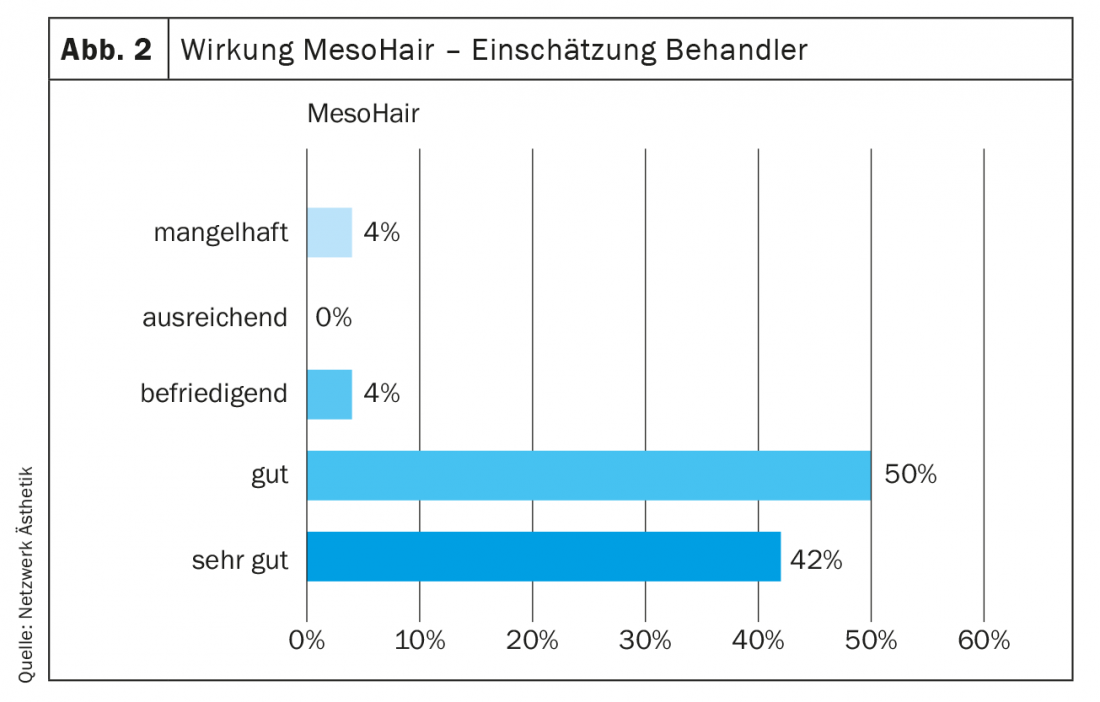
Side effects were not severe and numerically negligible with Mesohair, as might be expected with regenerative therapies. The distribution of patients’ satisfaction from their own perspective and that of their treating colleagues, shown in Figures 1 and 2 , is interesting. Both values are extremely high and must nevertheless initially be taken with caution, even though they indicate a very positive trend.
Hair loss was also the most commonly treated indication for PRP at 54%. Statistically, only the self-assessment of the results by the practitioners was available here in the first survey and also not differentiated according to indications. Figure 3 shows that 69.5% of the respondents rated the results as good and very good. From my own experience with PRP, I can say that if the indication of hair loss were evaluated, the numbers would improve significantly again.
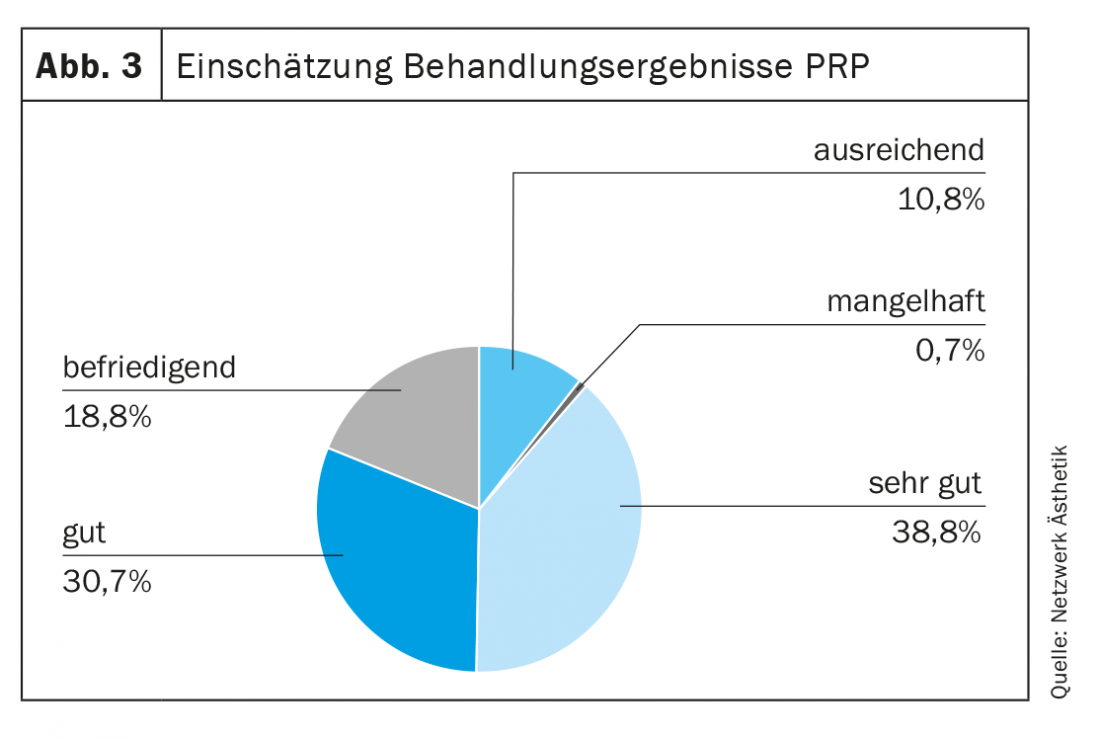
Combination as ultima ratio
First of all, about the treatment protocol of each therapy used in the network: MesoHair should include at least 6, better 8 treatments, first at intervals of 2, later 4 weeks. PRP should include 2-4 treatment sessions, each one month apart. Both therapies require 1-2 treatments per year for maintenance. It is interesting to note that today already 45.5% of the surveyed members combine PRP with MesoHair (Fig. 4).
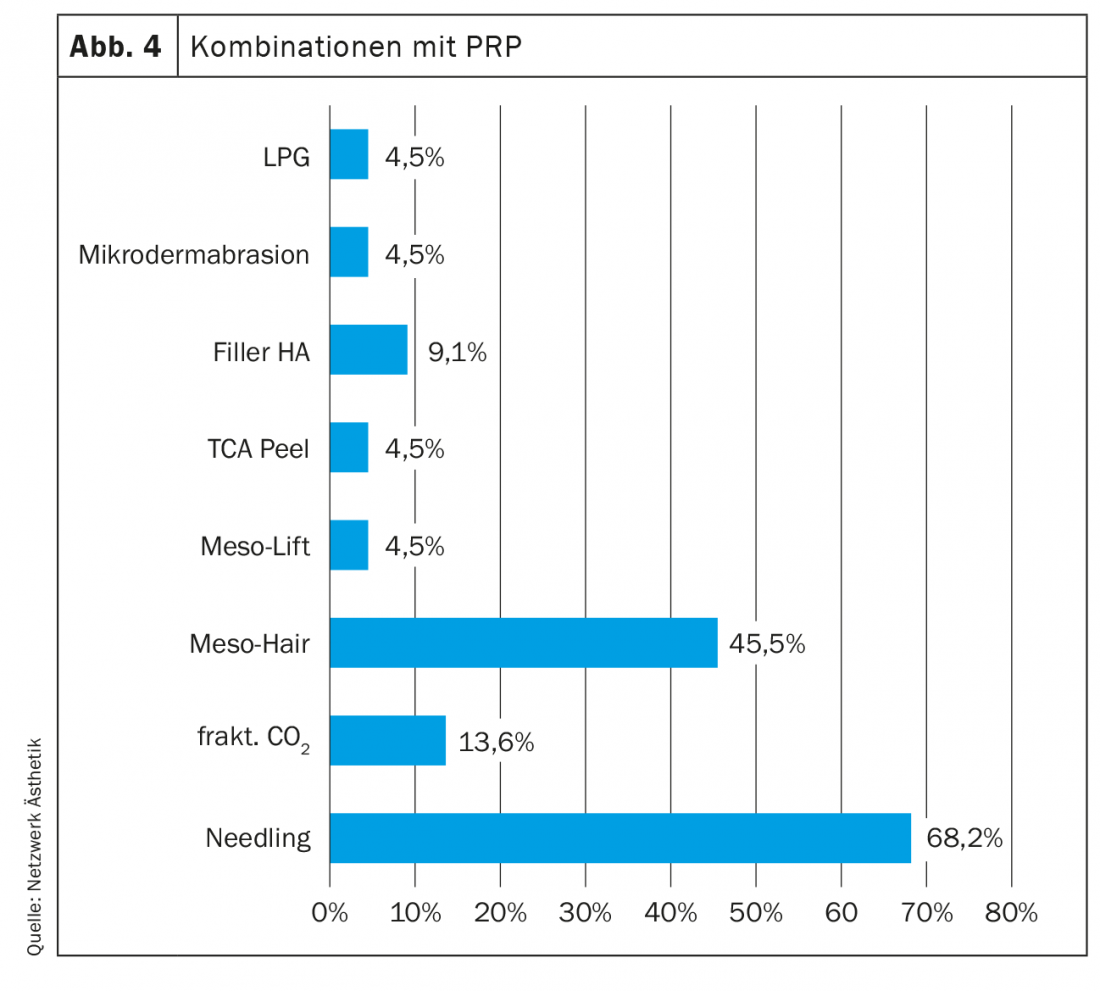
We have considered that a full combination therapy should definitely be used when the treatment with meso or PRP alone does not achieve sufficiently good results, when the patients’ level of suffering is extremely high and when the onset of hair loss is further back in time.
The treatment scheme presented in Overview 1 should be considered as a first proposal to obtain common standards. Out of several options, we initially chose this one. If it turns out that a different mixture, e.g. first only PRP, then MesoHair, or a different weighting of the two therapy parts brings more optimal results, we will change this first proposal. Here, we first want to collect and evaluate the experiences of our members in order to make final recommendations. The combination of PRP and needling has also been mentioned in the literature [47,55–58]. However, the handling of a hair treatment seems to be a bit critical here, because the bleeding of needling is necessary, so the patients would have to wash their hair after the treatment, which is contraindicated in our eyes directly after the treatment.
Treatment tools
For both meso and PRP therapy, we use pain-reducing meso-relle® needles (Biotekne) with 30 gauges in diameter to make the experience as comfortable as possible for patients. The use of a compressed air operated injection gun is unanimously accepted in the network for mesotherapy – even for hair loss. According to the protocol, the single injection is performed first at intervals of 1 cm, followed by nappage (= continuous rapid injection volleys).
We are not yet in complete agreement about hair treatment with PRP. Some colleagues also work with the gun because of the low pain, others prefer to inject by hand to a slightly greater depth to minimize the loss of PRP that inevitably occurs when using a gun.
Summary
In the end, the practice of a theoretically conceivable approach was convincing. Extremely many female patients, who very often develop depressive symptoms due to hair loss, can be helped by combining two less invasive procedures that can be considered harmless. In case of mesotherapy, strong allergic persons should not be treated because of the risk of allergic shock, the contraindications in case of PRP do not need to be listed here, they are generally known. To what extent needling will become important for combination therapy is still an open question, although encouraging publications are available.
The proportion of male patients for hair treatment is increasing, here, however, due to the often genetic disposition, it can be assumed that the onset of hair loss can be delayed by preventive treatment with MesoHair and/or PRP, for how long, no valid data are yet available. However, preventive treatment is increasingly in demand among male patients.
The colleague Schaart mentioned at the beginning of this article recently gave a lecture on the success of a hair consultation at the DERM in Frankenthal, and I would like to quote him here at the end because he gave some important tips on mistakes that can be made in communicating with patients suffering from hair loss [70] (Overview 2).
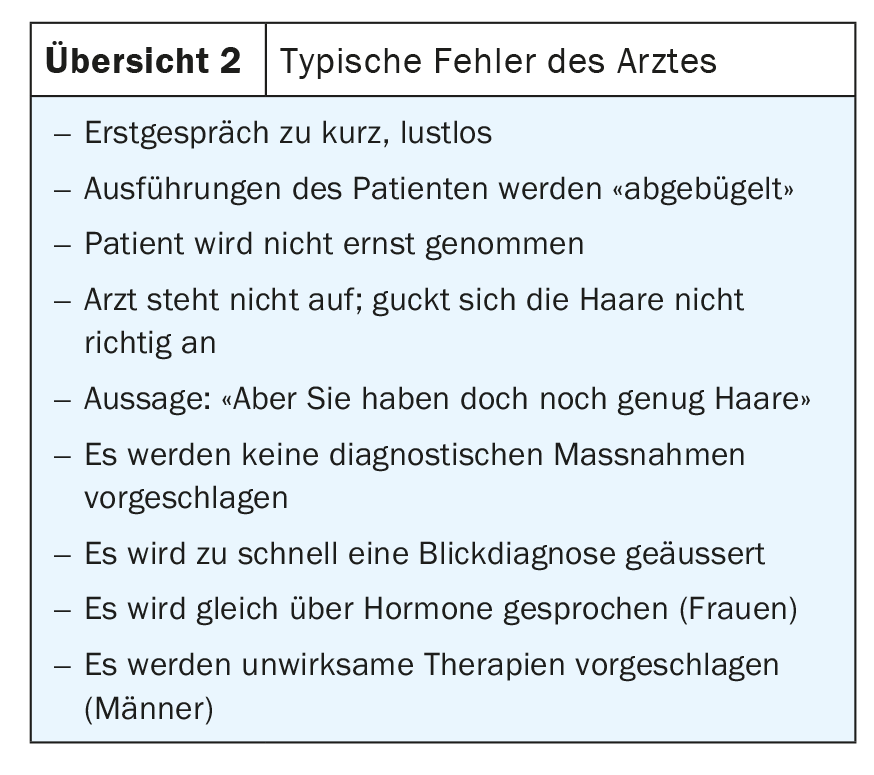
Take-Home Messages
- Hair loss, especially of female patients, has existential significance for them with strong effects on the psyche. Treatment of Alopecia Areata and Diffuse Effluvium is possible and useful.
- The minimum and maximum targets should be discussed with the patients in advance and should also be included in the education (participants in the advanced treatment training courses can use the network’s education).
- First use all conservative therapies paid by health insurance companies, only in case of failure offer the possibility of combination meso/PRP.
- If no change is visible after 2 PRP and 4 meso treatments, discontinuation of therapy should be considered.

Literature:
- Weidmann M, Reich N: Aesthetics – Mesotherapy on the rise, new horizons through standardized treatment protocols. DERM 2011; 17.
- Weidmann M: Mesotherapy today – development of a treatment protocol: attempt to create standards by the NETWORK-AestheticsMeso. KosMed 2010; 2: 80-83.
- Weidmann M: First statistical results on aesthetic mesotherapy. KosMed 2012; 5: 30-31.
- Weidmann M: Aesthetic Mesotherapy Today. Cutting-edge research in aesthetic dermatology and dermatosurgery 2015; 78-81.
- Funke G: Successfully performing aesthetic mesotherapy. KosMed 2014; 35: 256-257.
- Weidmann M, Torzicky M, Funke G, Eichelberg D: Alternative methods for the treatment of diffuse effluvium and alopecia areata: mesotherapy and platelet rich plasma therapy. KosMed 2015; 35: 192-194.
- Weidmann M: 10 years of aesthetic mesotherapy of NETZWERK-ÄsthetikMeso. KosMed 2016; 2: 60-64.
- Weidmann M: Mesotherapy is clearly on the rise. KosMed 2017; 1: 34-36.
- Weidmann M: The importance of mesotherapy for aesthetic indications, Aesthetic Dermatology & Cosmetology 2018; 3; doi: 10.1007/s12634-018-5634-0.
- Aust MC, Knobloch K, Reimers K, et al: Percutaneous collagen induction therapy: an alternative treatment for burn scars. Burns 2010; 36: 836-843.
- Aust MC, Bahte S, Fernandes D: Image atlas of percutaneous collagen induction: principles, indications, applications. Berlin: KVM 2013.
- Aust MC, Fernandes D, Kolokythas P, et al: Percutaneous collagen induction therapy: an alternative treatment for scars, wrinkles, and skin laxity. Plast Reconstr Surg 2008; 121: 1421-1429.
- Aust MC, Reimers K, Repenning C, et al: Percutaneous collagen induction: minimally invasive skin rejuvenation without risk of hyperpigmentation: fact or fiction? Plast Reconstr Surg 2008; 122: 1553-1563.
- Rezai K: Microneedling – Minimally Invasive Treatment of Acne Scars. the German Dermatologist 2009; 1: 41-42.
- Rezai K: Aesthetic needling. KosMed 2013; 34: 178-179.
- Rezai K: Needling for acne scars. Skin 2015; 26: 266-269.
- Rezai K: Needling for the treatment of wrinkles. KosMed 2015; 6: 232-234.
- Trink A, Sorbellini E, Bezzola P, et al: A Randomized, Double-blind, Placebo- and Active-controlled, Half-head Study to Evaluate the Effects of Platelet-Rich Plasma on Alopecia Areata. Br J Dermatol 2013; 169: 690-694; doi: 10.1111/bjd.12397.
- Singh S: Role of Platelet-Rich Plasma in Chronic Alopecia Areata: Our Centre Experience. Indian J Plast Surg 2015; 48: 57-59; doi: 10.4103/09700358.155271.
- Gkini MA, Kouskoukis AE, Rigopoulos D, Kouskoukis K: Platelet-Rich Plasma as a Potential Treatment for Noncicatricial Alopecias. Int J Trichology 2015; 7: 54-63; doi: 10.4103/0974-7753.160098.
- Eppley BL, Pietrzak WS, Blanton M: Platelet-Rich Plasma: A Review of Biology and Applications in Plastic Surgery. Plast Reconstr Surg 2006; 118: 147e-159e.
- Weinberg WC, Goodman LV, George C, et al: Reconstitution of Hair Follicle Development in Vivo: Determination of Follicle Formation, Hair Growth, and Hair Quality by Dermal Cells. J Invest Dermatol 1993; 100: 229-239.
- Driskell RR, Giangreco A, Jensen K, et al: SOX2-Positive Dermal Papilla Cells Specify Hair Follicle Type in Mammalian Epidermis. Development 2009; 136: 2815-2823; doi: 10.1242/dev.038620.
- Perez-Meza D, Leavitt M, Mayer M: The Growth Factors Part 1: Clinical and Histological Evaluation of the Wound Healing and Revascularization of the Hair Graft After Hair Transplant Surgery. Hair Transplant Forum Int 2007; 17: 173-175.
- Perez-Meza D: Part II The Use of Autologous Rich and Poor Plasma to Enhance the Wound Healing and Hair Growth in Hair Restoration. In programs and abstracts. 13th ISHRS annual meeting 2005; Sydney, Australia.
- Uebel C: A New Advance in Baldness Surgery Using Platelet-Derived Growth Factor. Hair Transplant Forum Int 2005; 15: 77-84.
- Greco J, Brandt R: The Effects of Autologous Platelet Rich Plasma and Various Growth Factors on Non-transplanted Miniaturized Hair. Hair Transplant Forum Int 2009; 19: 49-50.
- Zheng Y, Du XB, Wang W, Boucher B: Organogenesis from Dissociated Cells: Generation of Mature Cycling Hair Follicles from Skin-derived Cells. J Invest Dermatol 2005; 124: 867-876.
- Takakura N, Yoshida H, Kunisada T, et al: Involvement of Platelet Derived Growth Factor Receptor-a in Hair Canal Formation. J Invest Dermatol 1996; 107: 770-777.
- Dohan ED, Rasmusson L, Albrektsson T: Classification of Platelet Concentrates: From Pure Platelet-Rich Plasma (P-PrP) to Leucocyte and Platelet-Rich Fibrin (L-PrF). Trends Biotechnol 2009; 27: 158-167.
- Werther K, Christensen IJ, Nielsen HJ: Determination of Vascular Endothelial Growth Factor (VEGF) In Circulating Blood: Significance of VEGF in Various Leucocytes and Platelets. Scand J Clin Lab Invest 2002; 62: 343-350.
- Everts PA, Hoffmann J, Weibrich G, et al: Differences in Platelet Growth Factor Release and Leucocyte Kinetics During Autologous Platelet Gel Formation. Transfus Med 2006; 16: 363-368.
- Everts PA, Jakimowicz JJ, van Beek M, et al: Reviewing the Structural Features of Autologous Platelet-Leukocyte Gel and Suggestions For Use in Surgery. Eur Surg Res 2007; 39: 199-207.
- Moojen DJ, Everts PA, Schure RM, et al: Antimicrobial Activity of Platelet-Leukocyte Gel Against Staphylococcus Aureus. J Orthop Res 2008; 26: 404-410.
- Dohan Ehrenfest DM, Corso MD, Diss A, et al: Three-dimensional architecture and cell composition of a Choukroun’s platelet-rich fibrin clot and membrane. J Periodontol 2010; 81: 546-555.
- Yong Miao, Ya-Bin Sun, Xi-Jin Sun, et al: Promotional Effect of Platelet-Rich Plasma on Hair Follicle Reconstitution in vivo. Dermatol Surg 2013; 39: 1868-1876.
- Takikawa M, et al: Enhanced Effect of Platelet-Rich Plasma Containing a New Carrier on Hair Growth. Dermatol Surg 2011; 37: 1721-1729.
- Zheng JL, Hye-In C, Dae-Kyoung C, et al: Autologous Platelet-Rich Plasma: A Potential Therapeutic Tool for Promoting Hair Growth. Dermatol Surg 2012; 38: 1040-1046.
- Kui YP, Hyun KK, Beom JK, Myeung Nk: Platelet-Rich Plasma for Treating Male Pattern Baldness, Letter to the Editor. Dermatol Surg 2012; 38: 2042-2044.
- Schiavone G, Raskovic D, Greco J, Abeni D: PRP for Androgenetic Alopecia: A Pilot Study; Dermatolog Surg 2014; 40: 1010-1019.
- Uebel CO, da Silva JB, Cantarelli D, Martins P: The role of platelet plasma growth factors in male pattern baldness surgery. Plast Reconstr Surg 2006; 118: 1458-1466.
- Li ZJ, Choi HI, Choi DK, et al: Autologous platelet rich plasma: a potential therapeutic tool for promoting hair growth. Dermatol Surg 2012; 38: 1-7.
- Williams D, Profeta K, Stenn KS: Isolation and culture of follicular papillae from murine vibrissae: an introductory approach. Br J Dermatol 1994; 130: 290-297.
- Gentile P, Garcovich S: Systematic Review of Platelet-Rich Plasma Use in Androgenetic Alopecia Compared with Minoxidil®, Finasteride®, and Adult Stem Cell-Based Therapy. Int J Mol Sci 2020; 21: 2702; doi: 10.3390/ijms21082702.
- Gupta AK, et al: Platelet-Rich Plasma as a Treatment for Androgenetic Alopecia, Dermatol Surg 2019; 45: 1262-1273; doi: 10.1097/DSS.0000000000001894.
- Girijala RL, et al: Platelet-rich plasma for androgenic alopecia treatment: a comprehensive review, Dermatol Online J 2018; 24: 13030/qt8s43026c.
- English Jr RS, et al: Microneedling and Its Use in Hair Loss Disorders: A Systematic Review, Dermatol Ther (Heidelb) 2022; 12: 41-60; doi: 10.1007/s13555-021-00653-2.
- Elghblawi E: Platelet-rich plasma, the ultimate secret for youthful skin elixir and hair growth triggering. J Cosmet Dermatol 2017; 1-8; doi: 10.1111/jocd.12404.
- Rose PT: Advances in Hair Restoration. Dermatol Clin 2018; 36: 57-62; doi: 10.1016/j.det.2017.09.008.
- Rose PT: Combination Approaches for Combatting Hair Loss. Dermatol Clin 2021; 39: 479-485; doi: 10.1016/j.det.2021.04.004.
- Roohaninasab M, et al: Systematic review of platelet-rich plasma in treating alopecia: Focusing on efficacy, safety, and therapeutic durability. Dermatologic Therapy 2021; 34: e14768; doi: 10.1111/dth.14768.
- Kaushik A, et al: Platelet-Rich Plasma: The Journey so Far ! Indian Dermatology Online J 2020; doi: 10.4103/idoj.IDOJ_369_19.
- Almohanna HM, et al: Platelet-Rich Plasma in the Treatment of Alopecia Areata: A Review. Journal of Investigative Dermatology Symposium Proceedings 2020; 20: S45eS49; doi: 10.1016/j.jisp.2020.05.002.
- Lin MY, et al: Progress in the Use of Platelet-rich Plasma in Aesthetic and Medical Dermatology. JCAD Journal of Clinical And Aesthetic Dermatology 2020; 13: 28-35.
- Gupta AK, Quinlan EM, Venkataraman M, Bamimore MA: Microneedling for hair loss. J Cosmet Dermatol 2021; doi: 10.1111/jocd. 14525.
- Lee YB, Eun YS, Lee JH, et al: Effects of topical application of growth factors followed by microneedle therapy in women with female pattern hair loss: a pilot study. J Dermatol 2013; 40(1): 81-83.
- Shah KB, Shah AN, Solanki RB, Raval RC: A comparative study of microneedling with platelet-rich plasma plus topical minoxidil (5%) and topical minoxidil (5%) alone in androgenetic alopecia. Int J Trichol 2017; 9(1): 14-18.
- Aggarwal K, Gupta S, Jangra RS, et al: Dermoscopic assessment of microneedling alone versus microneedling with platelet rich plasma in cases of male pattern alopecia: a split-head comparative study. Int J Trichol 2020; 12(4): 156-163.
- Badran KW, et al: Platelet-Rich Plasma for Hair Loss, Review of Methods and Results, Facial Plast Surg Clin N Am 2018; doi: 10.1016/j.fsc.2018.06.008.
- Alves R, Grimalt R: A Review of Platelet-Rich Plasma: History, Biology, Mechanism of Action, and Classification. Skin Appendage Disord 2018; 4: 18-24; doi: 10.1159/000477353.
- Gentile P, Garcovich S: Advances in Regenerative Stem Cell Therapy in Androgenic Alopecia and Hair Loss: Wnt Pathway, Growth-Factor, and Mesenchymal Stem Cell Signaling Impact Analysis on Cell Growth and Hair Follicle Development. Cells 2019; 8: 466; doi: 10.3390/cells8050466.
- Stevens J, Khetarpal S: Platelet-rich plasma for androgenetic alopecia: A review of the literature and proposed treatment protocol. International Journal of Women’s Dermatology 2018; doi: 10.1016/j.ijwd.2018.08.004.
- Zahn J, et al: Platelet-Rich Plasma as an Autologous and Proangiogenic Cell Delivery System. Mediators Inflamm 2017: 1075975; doi: 10.1155/2017/1075975.
- Felthaus O, et al: Effects of different concentrations of Platelet-rich Plasma and Platelet-Poor Plasma on vitality and differentiation of autologous Adipose tissue-derived stem cells. Clinical Hemorheology and Microcirculation 2017; doi: 10.3233/CH-160203.
- Cervantes J, et al: Effectiveness of Platelet-Rich Plasma for Androgenetic Alopecia: A Review of the Literature. Skin Appendage Disord 2018; 4: 1-11; doi: 10.1159/000477671.
- Giesse S, Stollwerck P: Evaluation of a questionnaire on the use of PRP in aesthetics; lecture MASTER Conference 2019, Frankfurt/Main.
- Giesse S, Stollwerck P, Koenen W, Brandl D: Platelet Rich Plama (PRP): First statistical evaluation by the Network Aesthetics PRP Report 2019. KosMed 2020; 5: 166-167.
- Weidmann M, Lettko M, Prantl L: Injection lipolysis. J Aest Chir 2016; doi: 10.1007/s12631-016-0047-2.
- Hasengschwandtner F: Lipolysis Report: Statistical analysis of a survey of physicians of the NETWORK-Lipolysis. KosMed 2013; 1: 29-30.
- Schaart FM: How do I establish a successful hair consultation? Lecture Congress DERM Frankenthal 2022.
DERMATOLOGIE PRAXIS 2022; 32(5): 6-12



